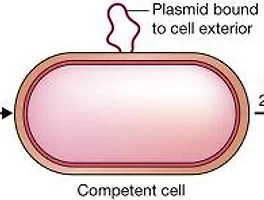Date
2011. 4. 12
Subject
To learn mitosis of plant and observe the mitosis of onions
Abstract
Results
A. Sketch the each stage of cell cycle based on your observation.
Interphase: There is dark round nucleus.
Prophase: Chromatin is condensing. Nuclear envelope disappeared. Chromatin is in the middle of the cell yet.
Metaphase: Chromosomes are located at the metaphase plate. The ends of each chromosome face the end of the cell.
Anaphase: Chromatids are separated each other and drawn along to the end of the cell.
Telophase: The chromatids are getting dissolved. There are a cell plate in the middle of the cell.
Discussion
1. What is the principle of dyeing the nucleus of the onion cell by acetocarmine solution?
Chromatin은 DNA 분자와 histone protein들로 이루어져있다. 이들은 static electrical attraction에 의해 붙어있다. DNA는 인산기를 가지기 때문에 음전하를 띠고, histone protein들은 positive charged amino acid들을 많이 가지기 때문에 양전하를 띤다. 이것이 인력을 유발하는 것인데, dye 역시 이 원리를 이용한다. Dye는 주로 base로, 수용액 상에서 양전하를 띠게 되어 음전하의 DNA에 붙게 된다. 이를 microscope를 통해 보면 chromatin(혹은 chromosome)이 dye의 색을 띠는 것으로 보이는 것이다.
2. What structural features between plant and animal cel make different type of cytokinesis during cell division?
Animal cell은 cell wall이 없으며 주로 actin filament로 된 cytoskeleton이 세포의 모양을 유지하고 있다. Animal cell은 아메바의 pseudopodium에서도 볼 수 있듯이 actin filament가 polymer와 monomer를 오가는 것을 통해 형태의 가변성을 가진다. Animal cell에서는 actin filament가 고리 형태로 세포 중심을 조여 cytokinesis를 일으키는데, 이것도 이러한 세포의 가변성 때문에 가능하다. 한편 plant cell은 단단한 cell wall이 있기 때문에 같은 방법으로 cytokinesis가 일어날 수 없다. 따라서 cell wall을 세포 가운데에 새롭게 형성하는 방법을 이용한다. 앞서 설명된 바와 같이 cell은 vesicle을 세포 중앙에 배열해 cell plate를 만들고, 이것이 점점 자라 새로운 cell wall이 된다. 즉, animal cell과 plant cell의 cytokinesis의 차이를 유발하는 것은 cell wall의 유무라고 할 수 있다.
References
「Biology」, BIOSCIENCE, 2009. 2. 27, p.232-236, 2011. 4. 12
'studio > scienza' 카테고리의 다른 글
| [Chapter 5] Transformation, Identification of recombinants (5) | 2015.05.11 |
|---|---|
| [생명과학/실험] Controlling the Growth of Bacteria (4) | 2015.05.09 |
| [Chapter 4] Ligation – joining DNA molecules together (8) | 2015.04.13 |
| [Chapter 4] Enzymes for cutting DNA – restriction endonucleases (2) | 2015.04.13 |
| [Chapter 4] The range of DNA manipulative enzymes (1) | 2015.04.13 |




